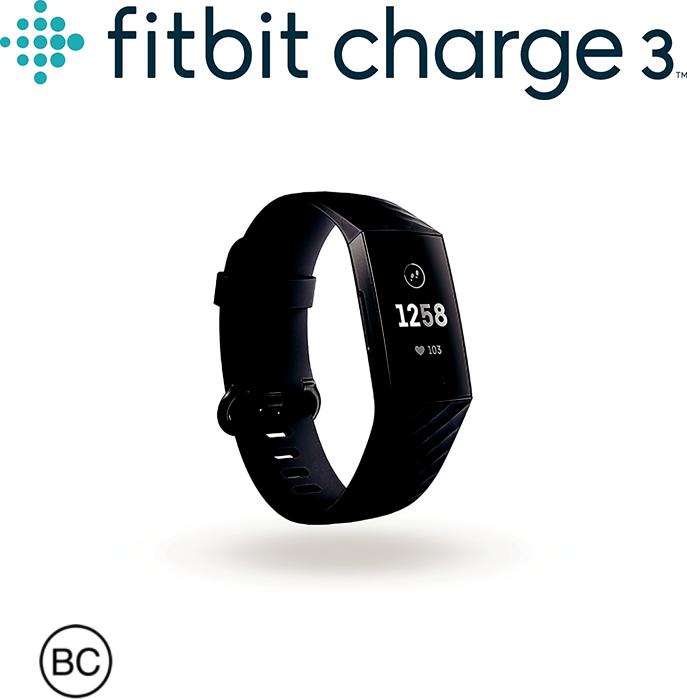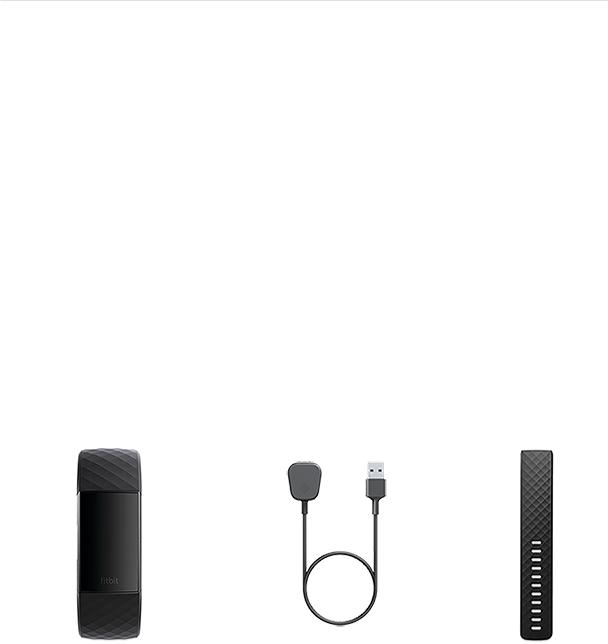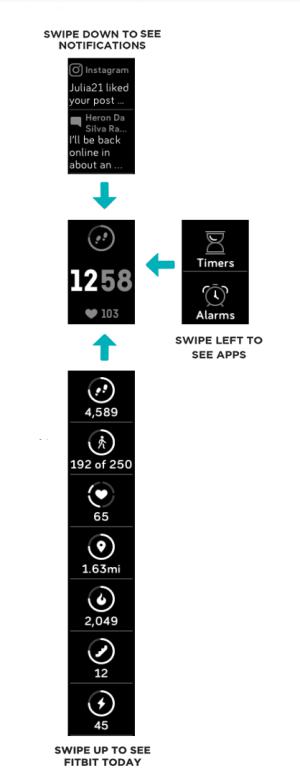Fitbit FB409, FB410 User Manual

UserManual
Version1.0

Table of Contents
Getting Started |
6 |
What's in this manual |
6 |
What's in the box |
6 |
Set up Fitbit Charge 3 |
8 |
Charge your tracker |
8 |
Set up with your phone or tablet |
10 |
Set up with your Windows 10 PC |
10 |
Sync data to your Fitbit account |
11 |
Wear Charge 3 |
12 |
Placement for all-day wear vs exercise |
12 |
Change the wristband |
14 |
Remove a wristband |
14 |
Attach a new wristband |
15 |
Basics |
16 |
Navigate Charge 3 |
16 |
Basic navigation |
16 |
Quick settings |
18 |
Adjust settings |
19 |
Check battery level |
19 |
Care for Charge 3 |
20 |
Notifications |
21 |
Set up notifications |
21 |
See incoming notifications |
21 |
Manage notifications |
22 |
Turn off notifications |
22 |
Timekeeping |
24 |
Enable or disable an alarm |
24 |
Dismiss or snooze an alarm |
25 |
2

Time events with the stopwatch |
26 |
Set a timer |
27 |
Activity and Sleep |
29 |
See your stats |
29 |
Track a daily activity goal |
29 |
Choose a goal |
29 |
See goal progress |
30 |
Track your hourly activity |
30 |
Track your sleep |
30 |
Set a sleep goal |
31 |
Set a bedtime reminder |
31 |
Learn about your sleep habits |
31 |
See your heart rate |
31 |
Adjust your heart rate setting |
32 |
Practice guided breathing |
32 |
Fitness and Exercise |
35 |
Track your exercise automatically |
35 |
Track and analyze exercise with the Exercise app |
35 |
GPS requirements |
35 |
Track an exercise |
36 |
Customize your exercise settings |
37 |
Check your workout summary |
38 |
Set an exercise goal |
40 |
Check your heart rate |
41 |
Default heart-rate zones |
41 |
Custom heart rate zones |
42 |
Share your activity |
43 |
Track your cardio fitness score |
43 |
Weather |
44 |
Check the weather |
44 |
Add or remove a city |
44 |
Restart, Erase, and Update |
46 |
3

Restart Charge 3 |
46 |
Erase Charge 3 |
46 |
Update Charge 3 |
46 |
Troubleshooting |
48 |
Heart-rate signal missing |
48 |
GPS signal missing |
48 |
Unexpected behavior |
49 |
General Info and Specifications |
50 |
Sensors |
50 |
Materials |
50 |
Wireless technology |
50 |
Haptic feedback |
50 |
Battery |
50 |
Memory |
51 |
Display |
51 |
Wristband size |
51 |
Environmental conditions |
51 |
Learn more |
52 |
Return policy and warranty |
52 |
Regulatory & Safety Notices |
53 |
USA: Federal Communications Commission (FCC) statement |
53 |
Canada: Industry Canada (IC) statement |
54 |
European Union (EU) |
55 |
Argentina |
56 |
China |
56 |
India |
57 |
Indonesia |
58 |
Israel |
58 |
Japan |
58 |
Mexico |
59 |
Morocco |
59 |
Nigeria |
59 |
Oman |
60 |
4

Philippines |
60 |
Serbia |
60 |
South Korea |
61 |
Taiwan |
61 |
United Arab Emirates |
63 |
Vietnam |
63 |
Safety Statement |
64 |
5

Getting Started
Get a deeper understanding of your body, your health, and your progress with Fitbit Charge 3. Take a moment to review our complete safety information at fitbit.com/safety.
What's in this manual
We'll explain how to create a Fitbit® account and make sure your tracker can transfer the data it collects to your dashboard. The dashboard is where you'll set goals, analyze historical data, identify trends, log food and water, keep up with friends, and much more. As soon as you're done setting up Charge 3, you're ready to start moving.
Next, we'll explain how to find and use the features that interest you and how to adjust your preferences. For more information, tips, and troubleshooting, browse our comprehensive help content at help.fitbit.com.
What's in the box
Your Fitbit Charge 3 box includes:
Tracker with smallwristband(color |
Additionallargeband |
andmaterialvary) |
Chargingcable |
(color andmaterialvary) |
6
The detachable wristbands on Charge 3 come in a variety of colors and materials, sold separately.
7

Set up Fitbit Charge 3
For the best experience, use the Fitbit app for iPhones and iPads, Android phones, or Windows 10 devices. If you don’t have a smartphone or tablet, you can also use a Bluetooth-enabled Windows 10 PC. Keep in mind that a phone is required for call, text, and calendar notifications.
Your Fitbit account asks for information such as height, weight, and sex in order to calculate your stride length and to estimate distance, basal metabolic rate, and calorie burn. When you set up your account, your name and photos are visible to all other Fitbit users. You have the option to share other information, but most of the information you provide is private by default.
Charge your tracker
A fully charged Charge 3 has a battery life of up to 7 days. Battery life and charge cycles vary with use and other factors; actual results will vary.
To charge your Charge 3:
1.Plug the charging cable into the USB port on your computer or a UL-certified USB wall charger.
2.Clip the other end of the charging cable to the port on the back of the tracker. The pins on the charging cable must lock securely with the port.
8

3.Make sure the button on your tracker is aligned with the button opening on the charging cable. You’ll know the connection is secure when you see a battery icon on the screen.
4.Charging fully takes about 1-2 hours. While the tracker charges, you can press the button to check the battery level. A fully charged tracker shows a solid battery icon with a smile.
9
Set up with your phone or tablet
The free Fitbit app is compatible with most iPhones and iPads, Android phones, and Windows 10 devices. If you're unsure if the Fitbit app is compatible with your device, see fitbit.com/devices.
To get started:
1.Find the Fitbit app in one of the locations below, depending on your device. • Apple App Store for iPhones and iPads.
• Google Play Store for Android devices. • Microsoft Store for Windows 10 devices.
2.Install the app.
3.When the app is installed, open it and tap Join Fitbit to be guided through a
series of questions that help you create an account.
4.Continue to follow the on-screen instructions to connect, Charge 3 to your Fitbit account.
When you're done with setup, read through the guide to learn more about your new tracker and then explore the Fitbit app.
Set up with your Windows 10 PC
If you don't have a smartphone, you can set up and sync Charge 3 with a Bluetoothenabled Windows 10 PC and the Fitbit app.
To get the Fitbit app for your computer:
1.Click the Start button on your PC and open the Microsoft Store.
2.Search for "Fitbit app". After you find it, click Free to download the app to your computer.
3.Click Microsoft account to sign in with your existing Microsoft account. If you don't already have an account with Microsoft, follow the on-screen instructions to create a new account.
4.Open the app and log in to your account, or click Join Fitbit to be guided through a series of questions that help you create an account.
5.Continue to follow the on-screen instructions to connect Charge 3 to your Fitbit account.
10
When you're done with setup, read through the guide to learn more about your new tracker and then explore the Fitbit dashboard.
Sync data to your Fitbit account
Sync Charge 3 to transfer data to the Fitbit app, where you can review your exercise history, see your sleep stages, log food and water, participate in challenges, and more. We recommend syncing at least once a day.
Each time you open the Fitbit app, Charge 3 syncs automatically when it's nearby. Charge 3 also syncs with the app periodically with the all-day sync option. To turn on this feature:
From the Fitbit app dashboard, tap the Account icon ( ) > Charge 3 tile > AllDay Sync.
) > Charge 3 tile > AllDay Sync.
You can also use the Sync Now option in the app at any time.
To learn more about syncing your device, see help.fitbit.com.
11

Wear Charge 3
Place Charge 3 around your wrist. If you need to attach a different size wristband, or if you purchased an accessory wristband, you'll find instructions in "Change the wristband" on page 14.
Placement for all-day wear vs exercise
When you're not exercising, wear Charge 3 a finger's width below your wrist bone.
For optimized heart-rate tracking while exercising, keep these tips in mind:
•Try wearing Charge 3 higher on your wrist during exercise for an improved fit and more accurate heart-rate reading. Many exercises, such as bike riding or weight lifting, cause you to bend your wrist frequently, which can interfere with the heart-rate signal if the tracker is lower on your wrist.
12

•Make sure the tracker is in contact with your skin.
•Don't wear your tracker too tight; a tight band restricts blood flow, potentially affecting the heart-rate signal. However, the tracker should be slightly tighter (snug but not constricting) during exercise than during all-day wear.
•With high-intensity interval training or other activities where your wrist is moving vigorously and non-rhythmically, the movement may limit the sensor's ability to provide a heart-rate reading. If your tracker doesn't show a heart-rate reading, try relaxing your wrist and staying still briefly (about 10 seconds). You should see a heart-rate reading.
13

Change the wristband
Charge 3 comes with a small wristband attached and an additional large bottom band in the box. Both the top and bottom bands can be swapped with accessory bands, sold separately. For wristband measurements, see "Wristband size" on page 51.
Remove a wristband
To remove the wristband:
1.Turn Charge 3 over and find the band latches —there's one on each end where the band meets the frame.
2.To release the latch, press down on the flat button on the strap.
3. Gently pull the band away from the tracker to release it.
4. Repeat on the other side.
14

Attach a new wristband
To attach a new band, press it into the end of the tracker until you feel it snap into place.
If you have trouble attaching the band or if it feels loose, gently move the band back and forth to make sure it is attached to the tracker
15

Basics
Learn how best to navigate, check the battery level, and care for your tracker.
Navigate Charge 3
Charge 3 has an OLED touchscreen display and one button.
Navigate Charge 3 by tapping the screen, swiping side to side and up and down, or by pressing the button. To preserve battery, Charge 3’s screen turns off when not in use.
Basic navigation
The home screen is the clock. On the clock:
o |
Swipe down to see notifications. |
o |
Swipe up to see your daily tips and stats. |
o |
Swipe left to scroll through the apps on your tracker. |
16

17

To open an app, swipe to find the app and then tap it.
Quick settings
Press and hold the button on Charge 3 for a faster way to use Fitbit Pay (on Fitbit Pay-enabled devices) and access select settings.
On the Quick Settings screen:
o When Screen Wake is on, turn your wrist towards you to turn on the screen.
oWhen the Notifications setting is turned on, Charge 3 displays notifications from your phone. For more information on how to manage notifications, see "Notifications" on page 21.
18

Adjust settings
Manage basic settings including brightness, heart rate, and button sensitivity directly on your tracker. Open the Settings app and tap a setting to adjust it. Swipe up to see the full list of settings.
Check battery level
Check your battery level at any time: from the clock face, swipe up. The battery level icon is in the top-left corner of the screen.
19
Your tracker continues to track your activity until your battery runs out.
Care for Charge 3
It's important to clean and dry your Charge 3 regularly. For instructions and more information, see fitbit.com/productcare.
20
